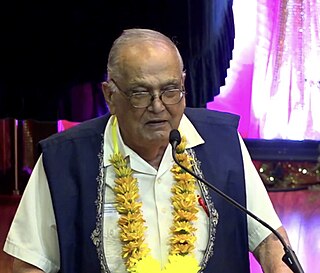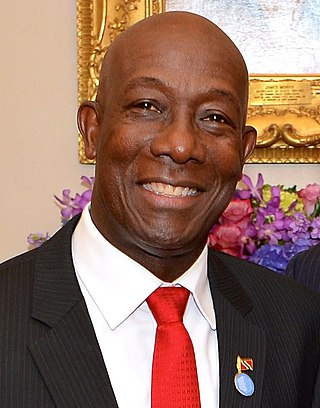
Indo-Trinidadians and Tobagonians or Indian-Trinidadians and Tobagonians are people of Indian origin who are nationals of Trinidad and Tobago, whose ancestors came from India and the wider subcontinent beginning in 1845 during the period of colonization.
The Sanatan Dharma Maha Sabha (SDMS), pronounced[sənɑːt̪ənəd̪ʰərməməɦɑːsəbʰɑː], colloquially known as the Maha Sabha, is the largest and most influential Hindu organization in Trinidad and Tobago. It operates 150 mandirs, over 50 schools, and has its own radio station, Radio Jaagriti 102.7 FM, and TV channel, TV Jaagriti. They also operate the Indian Caribbean Museum of Trinidad and Tobago. It was formed in 1952 when Bhadase Sagan Maraj engineered the merger of the Sanatan Dharma Association and the Sanatan Dharma Board of Control. An affiliated group, the Pundits' Parishad, has 200 affiliated pundits. The organisation's headquarters are located in St. Augustine.

Satnarayan Maharaj, also known as Sat Maharaj, was a Trinidadian and Tobagonian Hindu religious leader, educationalist, and civil rights activist in Trinidad and Tobago. He was the Secretary-General of the Sanatan Dharma Maha Sabha, a major Hindu organisation in Trinidad and Tobago and the wider Caribbean.
The culture of Trinidad and Tobago reflects the influence of Indian-South Asian, African, Indigenous, European, Chinese, North American, Latino, and Arab cultures. The histories of Trinidad and Tobago are different. There are differences in the cultural influences which have shaped each island. Trinidad and Tobago is an English-speaking country with strong links to the United Kingdom.

Hinduism in Trinidad and Tobago is the second largest religion. Hindu culture arrived to Trinidad and Tobago in 1845, with the arrival of the first Indian indentured laborers, the overwhelming majority of which were Hindu. According to the 2011 census there were 240,100 declared Hindus in Trinidad and Tobago.

Kamla Persad-Bissessar ; born Kamla Susheila Persad, 22 April 1952), often referred to by her initials KPB, is a Trinidadian and Tobagonian lawyer, politician and educator who is the Leader of the Opposition of Trinidad and Tobago, political leader of the United National Congress (UNC) political party, and was the prime minister of Trinidad and Tobago from 26 May 2010 until 9 September 2015. She was the country's first female prime minister, attorney general, and Leader of the Opposition, the first woman to chair the Commonwealth of Nations and the first woman of Indian origin to be a prime minister of a country outside of India and the wider subcontinent.
Indo-Caribbean Americans or Indian-Caribbean Americans, are Americans who trace their ancestry ultimately to India, though whose recent ancestors lived in the Caribbean, where they migrated beginning in 1838 as indentured laborers. There are large populations of Indo-Trinidadian and Tobagonians and Indo-Guyanese along with a smaller population of Indo-Surinamese, Indo-Jamaicans and other Indo-Caribbeans in the United States, especially in the New York metropolitan area and Florida. The Washington metropolitan area, Texas, and Minnesota also have small numbers of Indo-Guyanese and Indo-Trinidadians. Indo-Caribbean Americans are a subgroup of Caribbean Americans as well as Indian Americans, which are a subgroup of South Asian Americans, which itself is a subgroup of Asian Americans.
Drupatee Ramgoonai is a Trinidadian and Tobagonian chutney and chutney soca musician. She was responsible for coining the term "chutney soca" in 1987 with her first album, entitled Chutney Soca, which included both English and Hindustani versions of the songs. She had her biggest hit the following year when her "(Roll Up the Tassa) Mr. Bissessar" was a Road March contender. She was instrumental in tassa and chutney soca finding its place in Carnival and her efforts later led to competitions such as Chutney Soca Monarch.
Sundar Popo HBM, born Sundarlal Popo Bahora was a Trinidadian and Tobagonian musician. He is credited as being the father of Chutney music, beginning with his 1969 hit Nana and Nani.

Penal–Debe region is a region of Trinidad. The local government body is Penal–Debe Regional Corporation, a Regional Corporation of Trinidad and Tobago. The region has a land area of 246.91 km². Urban areas within Penal–Debe include Penal, where the corporation is headquartered, and Debe. The region is noted as a heartland of Indo-Trinidadian culture with Indians making up the vast majority of the region at 71% and the largest religion in the region being Hinduism at 43%.

Caribbean Hindustani is an Indo-Aryan language spoken by Indo-Caribbeans and the Indo-Caribbean diaspora. It is a koiné language mainly based on the Bhojpuri and Awadhi dialects. These Hindustani dialects were the most spoken dialects by the Indians who came as immigrants to the Caribbean from Colonial India as indentured laborers. It is closely related to Fiji Hindi and the Bhojpuri-Hindustani spoken in Mauritius and South Africa.
Hardbargain is a village on the island of Trinidad in the Caribbean country Trinidad and Tobago. It is situated on the southern edge of the Central Range.
In religion and spirituality, a pilgrimage is a very long journey or search of great moral significance. Sometimes, it is a journey to a sacred area or shrine of importance to innate faith. Members of every major religion participate in pilgrimages. A person who makes such a journey is called a pilgrim.

Kelly Village is a village in the Tunapuna–Piarco region of Trinidad and Tobago. The village is bordered by the Caroni River to the north, Caroni Village to the northwest, Frederick Settlement to the west, Warren to the southwest, Piarco to the north and east, St. Helena to the southeast, and Cunupia to the south. Kelly Village is located right next to the Piarco International Airport. The Caroni South Bank Road runs through the center of the village. The village is governed by the Kelly Village Council. Their member of parliament is Rishad Seecheran for Caroni East. The village has an online channel named Kelly Village TV (KVTV) that broadcasts the news and affairs of the village. The village has a Hindu temple: the Kelly Village Shiv Mandir. Kelly Village also has the Islamic Center Mosque. The village also has the Bethel's Spiritual Baptist Church, Hydraulic Road Kelly Village Community Bible Church, the Kelly Presbyterian Church, the Kelly Community Bible Church, and the Jesus Life Center Pentecostal Church.

The Temple in the Sea, officially known as the Sewdass Sadhu Shiva Mandir, is a Hindu mandir in Waterloo, Carapichaima, Couva–Tabaquite–Talparo, Trinidad and Tobago. Sewdass Sadhu, an indentured laborer from India, constructed the original temple in the Gulf of Paria in 1952. The temple was reconstructed by Randolph Rampersad and reopened in 1995.

Local elections in Trinidad and Tobago were held on 2 December 2019, contesting 139 electoral districts across Trinidad's 14 municipal corporation electoral areas.

The 2023 Trinidadian local elections were held on Monday, August 14, 2023, across all 141 electoral districts in Trinidad's 14 municipal corporation electoral areas. The elections follow a 3-2 ruling on May 18, 2023, from the United Kingdom's Judicial Committee of the Privy Council, the Republic of Trinidad and Tobago's highest court of appeal, which stated that the government's one-year extension of the mandate of councillors and alderman was unlawful. The matter was brought before the Law Lords of the Privy Council by Ravi Balgobin Maharaj, and his legal team led by Anand Ramlogan, SC. The legal action taken by Ravi Balgobin Maharaj was necessary after the PNM government decided to extend the election by one year, which the Privy Council ruled was inconsistent with the rule of Democracy. The judgement handed down to Ravi Balgobin Maharaj by the Law Lords was a landmark ruling in the Commonwealth and marks the first time that a Court upheld the rights of citizens to vote in a Local Government Election.









